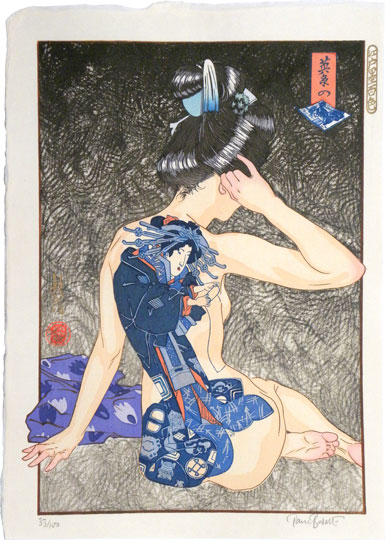

Paul Binnie
Scottish, b. 1967
A Hundred Shades of Ink of Edo: Eisen's Blue-Printed Pictures
(Edo zumi hyaku shoku: Eisen no Aizuri-e)
the background printed with bold sumi ink bokashi of baren swirls, a view of a seated nude from behind, she leans on her left hand while raising her right hand to touch her coiffure in the takashimada ('high Shimada') style, the tattoo based on an ukiyo-e print by Eisen depicting a courtesan rolling a letter; the series title cartouche in bronze-gold in the upper right margin, Edo zumi hyaku shoku, the print title to the left with the first portion, Eisen no, in the style of Eisen's signature, followed by a small aizuri-e (all blue print) of the original composition from which the tattoo is derived, signed in bronze-gold kanji, Bin-ni, with artist's red seal Binnie in the shape of a baren (the essential tool used by a woodblock printer to work the pigments into the paper), numbered and signed in pencil on the bottom margin, 33/100 Paul Binnie; July 2011
dai oban tate-e 16 7/8 by 12 in., 43 by 30.6 cm
For this design Binnie references the short-lived but highly influential fashion for aizuri-e (all blue) prints which exploded onto the print market circa 1830 with the arrival of an aniline dye imported from Europe (commonly known as Prussian blue). Unlike the natural pigments previously used for print-making; this blue was strong, vibrant, intense, and stable. The availability of such an appealing color inspired the tremendously successful landscape series, Thirty-six Views of Mt. Fuji by Katsushika Hokusai (1760-1849) and Fifty-three Stations of the Tokaido by Utagawa Hiroshige (1797-1858); essentially creating an entirely new and seemingly insatiable market for landscape prints. Keisai Eisen (1790-1848), one of the leading bijin-ga artists at the time, also produced landscapes utilizing the new blue pigment. In fact, there is scarce (if not unique) fan print by Eisen dated 1829 in the collection of the Brooklyn Museum of Art which is thought to be the earliest dateable aizuri-e.
The Binnie seal in the shape of a baren is a play on the print title, ai-ZURI-e (blue printed picture), thus the baren is the tool used for 'suri' (printing).
price: Sold







